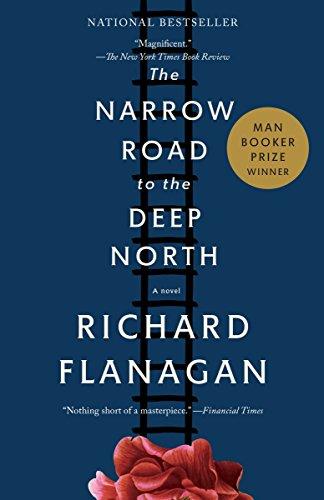
THE NARROW ROAD TO THE DEEP NORTH
Man Booker Prize Winner
A Best Books of the Year: The New York Times,
NPR, The Washington Post, The Minneapolis
Star-Tribune, The Economist, The Seattle Times,
Financial Times
August, 1943: Australian surgeon Dorrigo Evans
is haunted by his affair with his uncle’s young
wife two years earlier. His life, in a brutal Japanese POW camp on the
Thai-Burma Death Railway,
Man Booker Prize Winner
A Best Books of the Year: The New York Times,
NPR, The Washington Post, The Minneapolis
Star-Tribune, The Economist, The Seattle Times,
Financial Times
August, 1943: Australian surgeon Dorrigo Evans
is haunted by his affair with his uncle’s young
wife two years earlier. His life, in a brutal Japanese POW camp on the
Thai-Burma Death Railway, is a daily struggle to save the men under his
command. Until he receives a letter that will change him forever.
A savagely beautiful novel about the many forms of good and evil, of truth
and transcendence, as one man comes of age, prospers, only to discover all
that he has lost.
- Vintage
- Paperback
- April 2015
- 416 Pages
- 9780804171472
About Richard Flanagan
Richard Flanagan is the author of five previous
novels—Death of a River Guide, The Sound of One Hand Clapping, Gould’s
Book of Fish, The Unknown Terrorist, and Wanting—which have received
numerous honors and have been published in twenty-six countries. He
lives in Tasmania.
Praise
“Some years, very good books win the Man Booker Prize, but this year a
masterpiece has won it.”—A.C. Grayling, Chair of Judges, Man Booker
Prize 2014
“Richard Flanagan has written a sort of Australian War and Peace.”—Alan Cheuse, NPR
“A symphony of tenderness and love, a moving and powerful story that captures
the weight and breadth of a life . . . A masterpiece.”—The Guardian
Discussion Questions
What is the significance of the name of the novel, The
Narrow Road to the Deep North? Why might Flanagan
have chosen to name his book after Basho’s well-known
travelogue by the same name?
How does the author’s “visual” portrait of the characters
and the places they inhabit inform us about the state of the characters
and shape our reaction to their story? Evaluate Flanagan’s choice of
imagery and language. What type of imagery and language is most
prevalent in the book? Does Flanagan employ much symbolism?
How does this ultimately shape our experience of the book and our
understanding of the major themes addressed therein?
The POWs are put to work—often to their deaths—as slaves building
a railway for the Japanese emperor. What does this railway represent
to the Japanese people and their leader? Why are they so devoted to
its construction that they can be driven to violence and murder to
ensure its completion? Nakamura says that the English also utilized
“non-freedom” in order to ensure progress in their own country. What
does this seem to indicate about the nature of progress and how do his
comments change our perception of both the European and the Asian
characters and what is happening on the Line?
Evaluate Flanagan’s depiction of the dual nature of man. Consider
representations of good and evil, of man as philosopher-poet and man
as animal, of the public and private self. Does it seem to be possible for
man to resist this dual nature? Does the novel indicate whether man
can choose which side of his dual nature prevails over the other or is
this beyond man’s control?
Are there any representations of faith in the novel? If so, to what are
the characters faithful? There are also many examples of faithlessness
and unfaithfulness to be found in the book. What causes the characters
to lose their faith or to be unfaithful?
At the conclusion of the story, Flanagan presents us with the image of
Dorrigo opening a book only to find out that the final pages have been
torn out. Why do you think that the author chooses to employ this
image at the story’s end?
